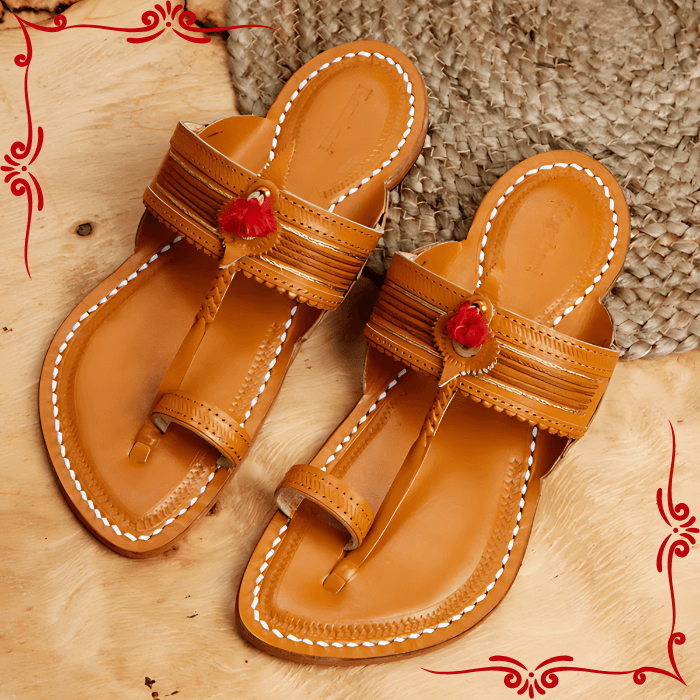What Are Chappals Made From – Kolhapuri chappals are more than just footwear—they are a cultural symbol and a testament to traditional Indian craftsmanship. Handcrafted in the city of Kolhapur, Maharashtra, these iconic leather sandals have been worn for generations and are admired for their durability, beauty, and comfort. This article takes you into the heart of the process and answers a common question: what are chappals made from?

Origin of Kolhapuri Chappals
Before diving into the materials, it’s important to understand the cultural roots of these chappals. The Kolhapuri chappal has been around for over 800 years, originally designed for royalty and warriors. Made entirely by hand using natural materials, each pair reflects a legacy of artisanal skill.
The Primary Material: Leather
1. Buffalo or Cowhide Leather
The main material used in Kolhapuri chappals is vegetable-tanned leather, usually derived from buffalo or cowhide. This leather is:
- Thick and durable
- Locally sourced
- Treated with natural ingredients to avoid harmful chemicals
Buffalo hide is often preferred for the sole because of its toughness, while cowhide might be used for the upper parts due to its softness.
2. Vegetable Tanning Process
Unlike commercial tanning which uses chromium salts, Kolhapuri chappals are made using eco-friendly vegetable tanning. The process involves:
- Soaking the hides in a mixture of water, salt, and plant-based agents like babul bark, myrobalan, and turmeric
- Sun-drying the leather for several days
This traditional method preserves the natural texture and enhances longevity.
Thread and Stitching Materials
3. Cotton or Nylon Thread
The parts of the chappal are stitched together using strong cotton or nylon thread. In earlier times, artisans used hand-spun cotton thread, but with advancements, nylon threads are often preferred for their increased strength and flexibility.
4. Hand Stitching
Most Kolhapuri chappals are hand-stitched, with intricate designs and patterns. This not only enhances the look but ensures flexibility and durability.
Natural Dyes and Polishes
5. Vegetable and Mineral-Based Dyes
To color the leather, artisans use:
- Natural vegetable dyes (such as henna, turmeric, and indigo)
- Mineral-based polishes for shine and finish
These dyes give the chappals their rich tones like dark brown, tan, black, and maroon while being safe for the skin.
6. Beeswax or Natural Oils
For the final shine and waterproofing, a mix of beeswax, castor oil, or linseed oil is used. This keeps the leather soft and supple.
Decorative Elements
Some Kolhapuri chappals feature:
- Brass nails to reinforce the sole
- Beads, bells, and embroidery for decorative purposes
- Leather braids and tassels for a traditional aesthetic
These features vary depending on the region and artisan style.
Tools Used in Crafting
- Hammer and awl for shaping and stitching
- Wooden molds to shape the chappals
- Polishing stones and brushes to finish the product
These tools are mostly traditional and passed down through generations.
Eco-Friendly and Sustainable
One of the reasons Kolhapuri chappals remain popular is their sustainability. From materials to processes, everything is eco-conscious:
- No synthetic chemicals
- Biodegradable materials
- Handmade with minimal machinery
Challenges and Modern Adaptations
While traditional methods are still widely practiced, some modern adaptations include:
- Using rubber soles for urban wear
- Adding foam padding for extra comfort
- Offering synthetic alternatives for vegan customers
However, the original leather-based Kolhapuris are still highly valued for their authenticity.
Conclusion
So, what are chappals made from? The answer goes beyond just leather. Kolhapuri chappals are crafted with care, using locally sourced leather, natural dyes, and traditional techniques. Every pair is a blend of culture, skill, and sustainability, making it a true representation of Indian heritage.
If you ever visit Kolhapur, don’t miss the chance to see artisans at work and bring home a pair of these timeless beauties!
Explore more about Kolhapur’s traditions, tourism, and heritage on KolhapurDistrict.in
Explore more about Sangli’s traditions, tourism, and heritage on SangliDistrict.in

